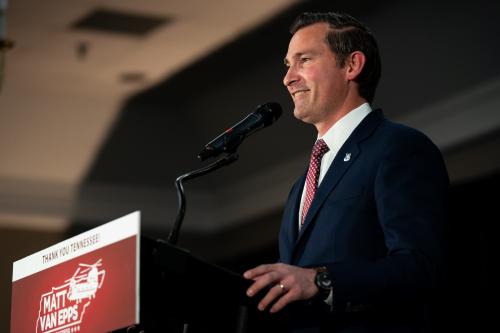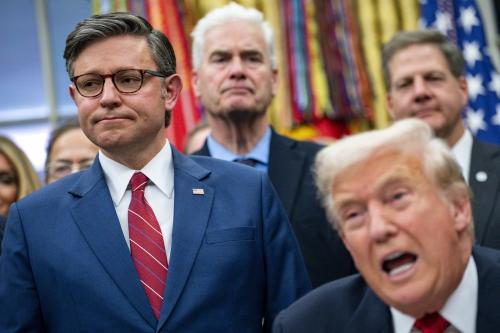Editor’s Note: As part of the 2014 Midterm Elections Series, experts across Brookings will weigh in on issues that are central to this year’s campaigns, how the candidates are engaging those topics, and what will shape policy for the next two years. In this post, Marisa Abrajano looks at voter turnout in communities of color.
One of the main concerns for communities of color in the upcoming midterm election is low turnout. In 2010, the turnout rate for Latinos is estimated at 31.2%, compared to 48.6% for Whites, 44% of Blacks and 31% for Asians. While it is the case that turnout in midterm elections is consistently lower than in presidential election cycles, this particular election is exacerbated by the general lack of enthusiasm amongst the electorate. Despite this lack of enthusiasm, national organizations such as Mi Familia Vota Education Fund (MFVEF) and the National Association of Latino Elected Officials (NALEO) are doing their part to mobilize Latino voters to get to the polls. However, an election where there is no defining issue that can easily galvanize Latinos to the polls means mobilization efforts by the parties, community organizations, and organized labor to name just a few will be a challenge. There was some hope that immigration would that issue – but Obama’s decision to delay any executive action on immigration until after the election has quelled such hopes.
Despite the lack of a “national” issue, the faith community, organized labor, and numerous community organizations across my home state of California are trying to energize communities of color to turnout in November. But this is no easy task. In the state’s June primary, turnout was the lowest ever for a statewide election at 25.2 percent of registered voters. To get more voters to the polls this November, these various entities are urging voters to get to the polls in support of Proposition 47, which they refer to as the “Safe Neighborhoods and Schools Act”. If the majority of Californians support this measure, it would reduce sentences in California for petty crimes, such as drug possession and shoplifting, to misdemeanors (currently, some of these crimes are charged as felonies). Passage of this law would give inmates serving felony sentences for such crimes the opportunity to get their sentences reduced. According the Legislative Analysts Office (LAO), the passage of Prop 47 would save the state hundreds of millions of dollars by reducing the prison population. It could then redirect these funds towards K-12 education and crime prevention. Opponents of the measure, including U.S. Senator Diane Feinstein (D), assert that reducing certain crimes to misdemeanors would release thousands of individuals who have already been convicted of such crimes.
Considering the demographics of the state’s inmate population, a change in these sentencing laws would greatly affect communities of color—slightly more than half (56%) of the state’s inmate population is non-white. Latinos are 41 percent of the inmate population, followed by Blacks at 29 percent and other races at 6 percent. Non-whites are therefore disproportionately represented in the inmate population relative to their population size in the state. Its potential impact on communities of color means that community organizations have been working hard to provide information about Prop 47, and urging their members to turnout in November. Despite these on-the-ground efforts, supporters of Prop 47 have launched a fairly modest advertising campaign (both television and radio).
There is, however, a coalition that’s been formed of more than 70 celebrities, musicians and activists—who refer to themselves as “Artists for 47”. This coalition includes well-known celebrities such as Brad Pitt, Jay-Z, Cameron Diaz, and Viola Davis. Their goal is to raise awareness about Prop 47; they are also urging individuals to vote, take a pledge in support of Prop 47 and use social media platforms to inform others about the initiative. They have also created an ad in favor of Prop 47, though it has been viewed only 238 times on You Tube. With the election less than two weeks away, it remains to be seen whether “Artists for 47” will engage in any other last minute mobilization efforts.
Midterm elections are known for being unrepresentative of the electorate, meaning that those who participate tend be older and more socioeconomically affluent than the voting population as a whole; recall that Whites also turnout at rates higher than non-Whites. If these same patterns hold true this November, the fate of Prop 47 as well as other key elections won’t be decided by a representative sample of the electorate. However, if the mobilizing efforts by grassroots and community organizations prove to be successful, then there’s the potential for the election outcome to be more representative of the state’s electorate as a whole.
The Brookings Institution is committed to quality, independence, and impact.
We are supported by a diverse array of funders. In line with our values and policies, each Brookings publication represents the sole views of its author(s).




Commentary
2014 Midterms: CA’s Prop 47 May Mobilize Communities of Color to the Polls
October 29, 2014